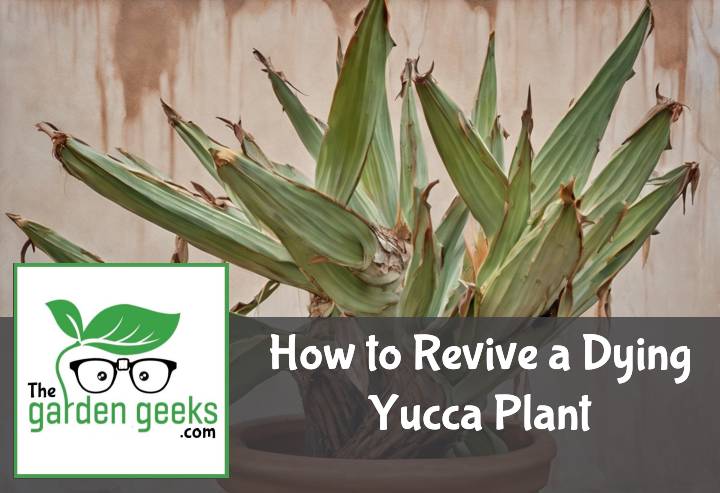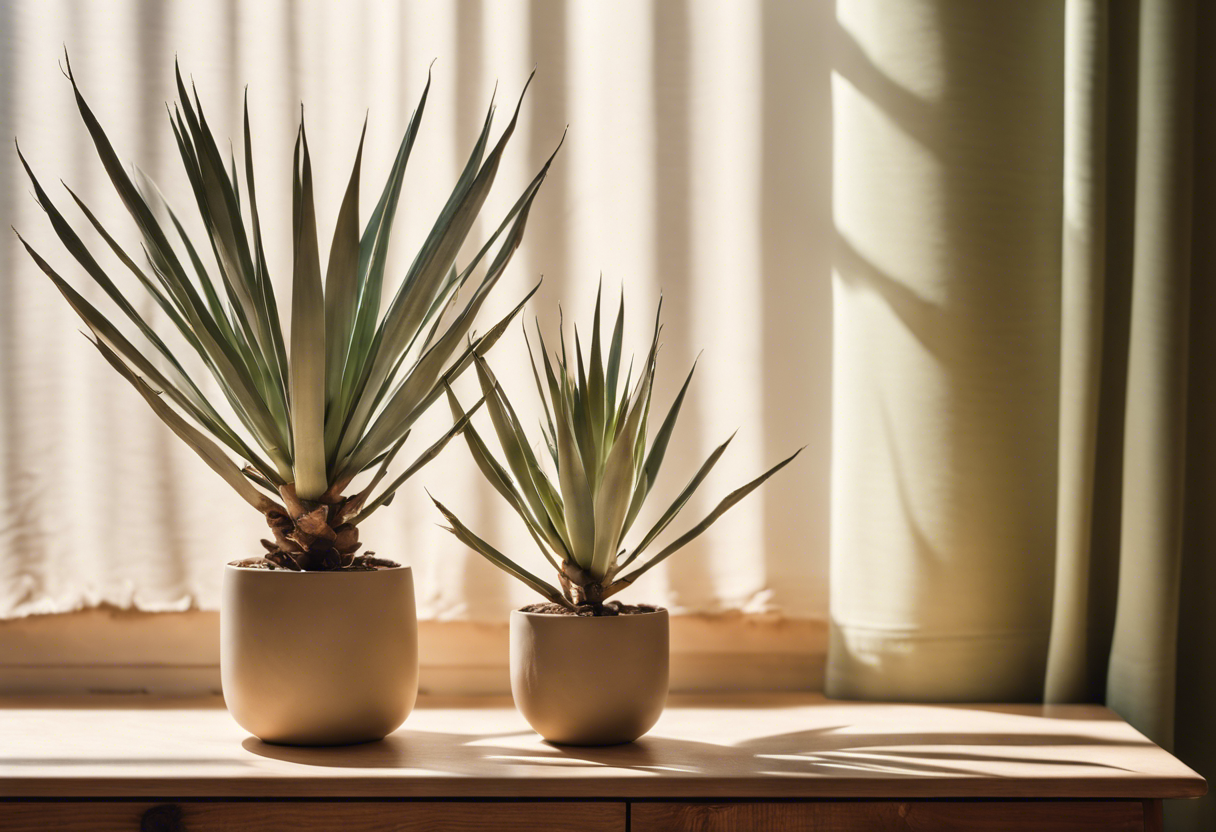Ever found yourself staring at your beloved Yucca plant, wondering why it’s looking a little under the weather? Well, you’re not alone. I’ve been there too, scratching my head and asking Google How to Revive a Dying Yucca Plant.
But worry no more! I’m here to share the wisdom I’ve gathered on this prickly predicament. So grab your gardening gloves and let’s turn that plant frown upside down! Keep reading about how to revive a dying Yucca plant.
Key Takeaways
- Identify the problem with your Yucca plant, such as overwatering, lack of sunlight, or pest infestation.
- Adjust watering habits; Yuccas prefer dry soil and too much water can cause root rot.
- Ensure the plant is getting enough light; Yuccas need full sun to partial shade.
- Check for pests and treat accordingly.
- Repot the plant if necessary, using well-draining soil and a pot with drainage holes.
- Prune dead leaves and stems to promote new growth.
Understanding Yucca Plant Health
When it comes to yucca plant care, it’s crucial to understand the health of your plant. Recognizing signs of an unhealthy yucca can be the difference between a thriving and dying plant. So, let’s dive into some common yucca plant problems and how we can improve yucca health.
Identifying Signs of a Dying Yucca Plant
Now, if you’re wondering how to revive a dying Yucca plant, first things first – you gotta know when your green buddy is feeling blue. One telltale sign is yellowing leaves in yuccas. If your yucca’s leaves are more mellow yellow than vibrant green, that’s a red flag.
Another symptom is wilting. A wilting yucca plant might look like it’s had one too many tequila sunrises – all droopy and sad. And then there are brown spots on yuccas. These unsightly blemishes are like acne for plants – nobody wants ’em!
Common Causes of Yucca Plant Decline
So what causes these dying yucca symptoms? Well, overwatering yuccas is a common culprit. It’s like giving your plant too much love – it just can’t handle it! On the flip side, under watering yuccas isn’t great either. It’s like sending your plant on a desert trek without any water.
Poor soil conditions for yuccas can also lead to decline. Imagine trying to grow in soil that doesn’t meet your needs – not fun, right? Lastly, don’t forget about light requirements for yucas and common diseases in yuccas – they can sneak up on you!
Assessing Your Yucca Plant’s Environment
The first step in the mission How to Revive a Dying Yucca Plant is to play detective and assess your yucca plant’s environment. This includes examining light conditions, soil quality, drainage, and temperature and humidity factors. Remember, your yucca plant isn’t just being dramatic – it’s telling you something about its environment!
Evaluating Light Conditions
Yuccas are like sunbathing beauties – they love their sunlight! To evaluate if your yucca is getting enough light, check if it’s placed near a window with plenty of natural light. If you’re growing your yucca indoors, ensure it has access to enough indoor lighting. Remember, too little or too much of anything can be harmful – even for plants! So make sure the yucca light requirements are met but not exceeded.
Checking Soil Quality and Drainage
Next up on our checklist is the soil quality and drainage. Yuccas prefer well-drained soil – they don’t like wet feet! Check if water drains quickly after watering. If it doesn’t, you might need to improve the drainage or change the soil mix. The soil quality for yuccas should be sandy and well-aerated for them to thrive.
Considering Temperature and Humidity Factors
Lastly, let’s talk about temperature and humidity. Yuccas aren’t fans of cold winters or high humidity levels. They prefer a desert-like climate – warm temperatures with low humidity levels. So keep an eye on these factors when trying to revive your dying yucca plant. Adjusting the yucca temperature needs and controlling humidity can make a world of difference in your plant’s health.
Reviving Your Yucca Plant: Immediate Actions
When your yucca starts looking a bit under the weather, don’t panic! There are immediate actions you can take to start reviving dying plants. The two key steps in your yucca plant care plan should be watering adjustments and pruning damaged parts.
Watering Adjustments for a Dying Yucca Plant
Yuccas are pretty tough cookies, but they can still suffer from too much or too little water. If you’re seeing underwatering symptoms, like drooping leaves, it’s time to up your watering game. But remember, these desert dwellers don’t like wet feet! Overdoing it could lead to overwatering yucca plants, causing root rot and other nasty issues.
The trick is finding the Goldilocks zone of watering – not too much, not too little. That’s where proper watering techniques for yuccas come into play. You want to give them a good soak, then let the soil dry out completely before the next watering session.
Pruning Damaged Parts of the Yucca Plant
Pruning is another vital step in learning how to revive a dying Yucca plant. It’s all about removing those sad-looking bits so the plant can focus on growing new, healthy ones.
To start with, you’ll need to get up close and personal with your yucca. Look for any parts that seem damaged or diseased – they might be discolored or have unusual growths. These are prime candidates for a prune!
Once you’ve identified the trouble spots, it’s time to whip out those shears and get pruning! Just remember – always make clean cuts and try not to damage any healthy parts of the plant in the process.
By taking these immediate actions for plant health, you’ll be well on your way to promoting healthy plant growth through pruning and reviving your yucca. Keep at it, and with a bit of luck and patience, you’ll see your plant bouncing back in no time!
Long-Term Care Strategies for a Healthy Yucca Plant
You’ve learned how to revive a dying Yucca plant, but what’s next? Well, it’s all about long-term care strategies. These include regular maintenance and preventive measures against common diseases and pests.
Regular Maintenance Tips for a Yucca Plant
First things first, let’s talk about regular yucca care. It’s not rocket science, folks! Just like you need your daily coffee fix, your yucca needs its own routine too.
Watering is key in maintaining healthy yuccas. But remember, they’re desert plants so don’t drown them! A good soak every week or two should do the trick.
Next up is sunlight. These guys love their sunbathing sessions! Make sure they get plenty of light but avoid direct midday rays to prevent leaf burn.
Lastly, don’t forget about repotting. As your plant grows, it might need a bigger home. So keep an eye out for roots peeking out of the drainage hole – that’s your cue!
Preventive Measures Against Common Diseases and Pests
Now onto the not-so-fun part – dealing with diseases and pests. But don’t worry, we’ve got some tips to help you safeguard your yucca plant.
Firstly, keep an eye out for any changes in your plant’s appearance. Yellow leaves or stunted growth could signal disease or pest issues.
Secondly, ensure good air circulation around your plant. This helps prevent fungal diseases which are common yucca plant issues.
Finally, consider using organic pesticides if you notice any bugs hanging around your plant too often. Remember though, prevention is better than cure! Regular maintenance goes a long way in keeping these pesky problems at bay.
To Wrap Up
Like a phoenix rising from the ashes, your yucca can make a comeback with a little TLC. The key takeaways from How to Revive a Dying Yucca Plant are proper watering, adequate lighting and temperature control.
Don’t let your yucca throw in the towel just yet! With these tips, you’ll be having ‘plantastic’ success in no time. Remember, every plant parent has their ups and downs – it’s all part of the grow process!





